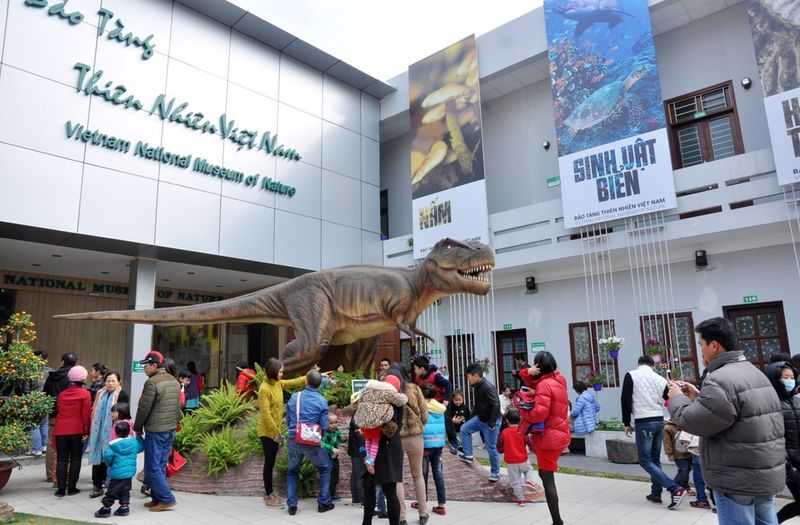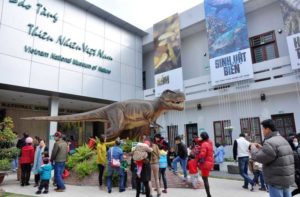Recently updated on October 10th, 2022 at 05:33 pm
The Vietnam National Museum of Nature is a showcase of a Vietnamese picture of the nature of plants and animals over 3.6 billion years. This is the ideal destination for those who love to explore nature, and want to explore the world, where a whole treasure of knowledge awaits you!
Vietnam National Museum of Nature is a national museum that was inaugurated in 2004. With an area of only 300m2 but it holds nearly 40,000 different specimens. The museum was established to store Vietnam’s valuable natural values over the past 3.6 billion years.
About Vietnam National Museum of Nature
Vietnam National Museum of Nature is considered the largest, new, and most modern museum among the museums present in Hanoi.
The museum introduces the most complete, specific and vivid, and comprehensive way of the values and characteristics of Vietnam’s nature.
Therefore, this is a tourist destination in Hanoi that is loved and visited by many tourists.
The total area of the museum is up to 1000m2, and the area used to display artifacts is only 300m2, but it fully and vividly reproduced the life of millions of years ago of the animal and plant world. rich and varied.

At the Vietnam Museum of Nature, about 1,400 rich specimens from many types including mammals, reptiles, amphibians, insects, plants… and many new species in Vietnam are displayed at the Vietnam Museum of Nature.
In addition, the Vietnam National Museum of Nature also receives hundreds of rare and precious animal and plant samples such as large whale samples weighing 18.5 tons, moonfish samples, fossil crocodile head bones… and many more. many samples and parts of rare wild animals such as tortoiseshell scales, rhinoceros horns, langurs, and monkeys,…
The museum’s exhibition space is not large, but it is arranged and decorated warmly and beautifully, choosing warm colors and yellow lights mainly to bring a warm feeling to visitors.
When stepping inside the Vietnam Museum of Nature, visitors will feel like going back in time to the past of ancient times or being lost in the wild nature with countless kinds of flora and fauna. rare. The artifacts here can be displayed in glass cabinets or placed outside.
Where is the Vietnam National Museum of Nature
Vietnam National Museum of Nature is located at 18 B-C Hoang Quoc Viet, Nghia Do ward, Cau Giay district, Hanoi.
How to get to the Vietnam National Museum of Nature
In addition to personal vehicles, you can choose public transport as a bus to move to the Vietnam National Museum of Nature. Some bus routes passing through this place are bus No. 08, 14, 20C, 22, 26, 32, and 38.
Opening time of the Vietnam National Museum of Nature
Currently, the Vietnam National Museum of Nature is open to visitors free of charge from Thursday to Sunday; in the morning frame from 8:30 a.m. to 11:30 a.m., in the afternoon frame from 1:30 a.m. to 4:30 p.m.
Every Tuesday and Wednesday, the museum is dedicated to welcoming groups of students or research groups who have pre-registered a tour schedule with the museum management board.
What’s in the Vietnam Museum of Nature?
The History of Life Exhibition
The History of the Life exhibition area is probably the most prominent and attractive area in the Vietnam Museum of Nature. This area displays fossil samples representing 4 periods of geological development on Earth including the Pre-Cambrian period (4,500 – 541 million years ago), the Paleozoic period (541 – 252 million years ago) ), the Mesozoic period (252 – 66 million years ago) and the Cenozoic period (66 million years to the present day).

Some fossil specimens in this area are recovered from famous originals in the world, others are specimens excavated in Vietnam and in other countries around the world.
Exhibition area History of human evolution

Next is the area displaying the History of Human Evolution. Human evolution started from a primate form, then evolved into different human forms (skillful people, upright people, smart people) and highly evolved to become modern humans like Currently.
The exhibition area of animal bones and the animal of the world
The exhibition area displays animal bones with many skeletons of animals such as frogs, carp, king cobras, tigers, ostriches, and pig-tailed monkeys…

Source: vov2.vov.vn/Website
The animal skeletons are stored, preserved intact to the smallest detail will bring you a sense of excitement.
Insect display area
The insect display area makes a strong impression on any visitor when coming here because of the largest collection of insects in Vietnam with hundreds of species of insects arranged in sets.

Source: redsvn.net/Website
Many orders of insects appeared about 400 million years ago such as dragonflies, mantises, etc.
Marine life display area

The marine life display area vividly and realistically reproduces the world under the ocean through specimens of fish species (some rare fish species such as moonfish specimens…), coral samples, and snail shells. …
Reptile and amphibian exhibition area
The reptile and amphibian exhibition will help you have a lot of interesting knowledge about extinct reptiles on Earth such as dinosaurs, or some types we can only see in our imagination. , through movies or 3D images…

At the Vietnam National Museum of Nature, there are displays of Indochinese pterosaurs and Velociraptor dinosaur bones originating from Mongolia.
Mushroom and plant exhibition area
Prominent at the mushroom and plant display area are samples brought from many different regions in three regions of Vietnam.
In addition to the fossils on display, in each area, there is a small projector system that shows and introduces the history, origin, and further description of that area, providing viewers with useful knowledge and information.
The 3D cinema room
In order to get an early ticket and be able to enter the theater after visiting the museum, you should register early with the museum management board from the beginning or during the visit.

The 3D cinema room shows 6 scientific films about human evolution, the universe, the sea, and the world of fish, dinosaurs, and insects.
Each day, the theater only has 4 screenings and each shift usually begins when a minimum of 15 people have signed up.


